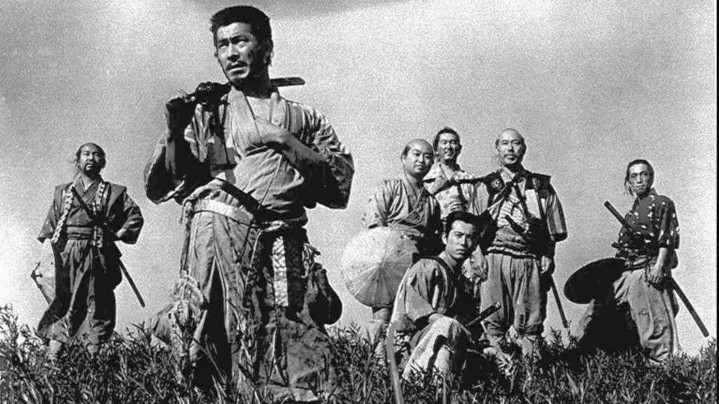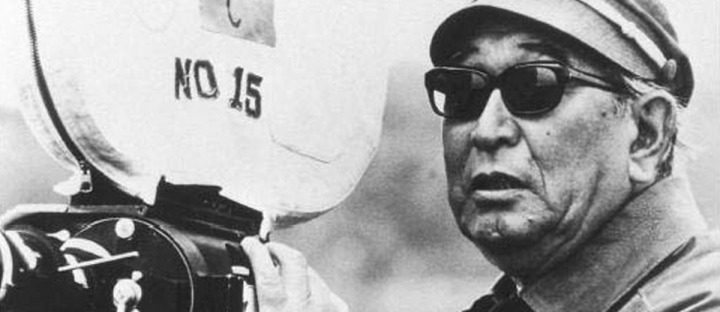This piece was written by Eric Hanson and Sean Gallagher.
In a far off village, a group of peasants have been besieged by a band of violent marauders. Hopelessly outmatched and unable to strategize, they enlist the help of a warrior turned mercenary. The mercenary, knowing they can’t defeat the marauders alone, decides to seek additional help, bringing together several other fighters as they prepare the village for a final stand against the siege. Fans of Star Wars will no doubt look at this plot and identify it as the premise for The Mandalorian episode entitled Sanctuary, widely considered one of the best the show had to offer. They’d be right of course, but this plot isn’t just found in The Mandalorian. It also happens to be the premise for Akira Kurosawa’s masterpiece, Seven Samurai.
[Credit: Toho]
Often considered one of the greatest filmmakers of all time, Kurosawa was a pioneer of Japanese cinema whose influence has been felt the world over. Star Wars is perhaps the most noteworthy series to claim his staple, and not just in this episode of The Mandalorian. Kurosawa’s influence has been a part of star wars all the way back in the beginning when it was just a dream from a young filmmaker named George Lucas.
WHO WAS KUROSAWA
In the world of cinema, few filmmakers attract as much praise as Kurosawa. With his unique visual style and stories that appealed to audiences worldwide, Kurosawa not only defined many genres of cinema with his rich samurai based adventures movies, but he might also have created some, as was the case with his still tense police thriller High and Low. Drawing heavily from the directing style of John Ford, Kurosawa was a big fan of American westerns, and incorporated many of those techniques into his own films. This trait initially got Kurosawa a lot of grief in his native Japan. Ironically his tributes to the western genre also helped reinvigorate it, with the style of his samurai movies becoming a major staple in the Spaghetti Western genre.

Many of Kurosawa’s films have already been remade for western audiences. The Clint Eastwood classic A Fistful of Dollars is an almost scene for scene remake of Yojimbo, something that earned director Sergio Leone a trip to court. Seven Samurai itself was also remade several times, both as a western with The Magnificent Seven (which was remade again in 2016) and as a Pixar animated film with A Bug’s Life. When looking at cinema across the world, one would be hard-pressed to find a place that doesn’t have some smattering of an influence by Kurosawa. Beloved by young artists the world over, Kurosawa captured the imagination of a young George Lucas, and though Kurosawa may have never visited a Star Wars set, he helped make history.
THE HIDDEN FORTRESS
George Lucas was first exposed to Kurosawa in film school, Having not been exposed to any foreign films during his childhood, Lucas quickly became enamored with the Japanese director’s work following a viewing of Seven Samurai, which he still considers his favorite.
“It’s really his visual style to me that’s so strong and unique, and a very powerful element in how he tells his stories. I think it comes from a generation of filmmakers that were still influenced by silent films, which is something that I’m very interested in from having come out of film school.”
While not his favorite, Lucas was nevertheless impressed with Kurosawa’s The Hidden Fortress. The Hidden Fortress tells of a pair of peasants named Tahei and Mataschichi who take up a job escorting a man and a woman across dangerous territory.
[Credit: Toho]
Along the way, the pair discover that the man is a general named Rokurota, and the girl is in fact a princess named Yuki. Tahei and Mataschichi are hardly heroic types. They are the most common characters in the film while the stakes revolve around the general and the princess. In spite of this, a significant portion of the film is told from their point of view, something that influences Lucas in creating his script.
“I decided that would be a nice way to tell the star wars story, which is take the two lowliest characters as Kurosawa did and tell the story from their point of view which in Star Wars’ case is the two droids.”
C-3P0 and R2-D2 are heavily based on Tahei and Mataschichi. Like that duo, they are lowly peasants who carry the plot for the early portions of the film, and like the pair that are unwittingly drawn into an adventure they are scarcely prepared to partake in. The film does eventually deviate from its source material, but earlier drafts by Lucas bore a much closer resemblance to Kurosawa’s adventure masterpiece.
“In the beginning, in one of the first drafts, I did have a little bit more of her and a Jedi, an older Jedi, trying to escape, but then it evolved into the story of Luke.”
While the end result wasn’t as close to Kurosawa’s original film in later drafts, Lucas did incorporate much of Kurosawa’s signature visual style in his film, one of the reasons the original is among the most visually unique in the series. Kurosawa was heavily influenced by Western films. How fitting that his work influenced one of the greatest space western operas of all time?
[Credit: Toho]
LATER INFLUENCES
The influence of Kurosawa on the original film carried over to the rest of the series. Some of these are more subtle than others, such as Darth Vader’s helmet being inspired by a samurai helmet. Others feature much broader strokes. As mentioned before, George Lucas’ earlier drafts for the original film bore a much closer resemblance to The Hidden Fortress. Eventually, some of those ideas would make it to the big screen. The idea of a queen in disguise attempting to flee from her pursuers would later become a central plot point in the first prequel film, The Phantom Menace.
It’s no surprise to learn that the hit Disney+ show, The Mandalorian, decided to pay homage to Seven Samurai in its fourth episode, Sanctuary. Directing this episode is Bryce Dallas Howard, daughter of Ron Howard, making her debut behind the camera. Jon Favreau, the showrunner of The Mandalorian, would state that this episode was probably the hardest to direct and that Howard was tossed in the deep end for this one. But since Bryce had never directing a TV show before (a few shorts and some documentaries), Favreau believed she wouldn’t be as intimidated by directed the Kurosawa inspired episode featuring a giant AT-ST. Fun fact: Bryce Dallas Howard met Kurosawa as a child when her father and Lucas had dinner with the director in Japan. Having met him, she was eager to honor the legendary director.
[Credit: Lucasfilm]
What’s more impressive is this isn’t even the first time Star Wars has paid homage to Kurosawa and Seven Samurai. The season two episode of the animated show The Clone Wars, Bounty Hunters, is a 22-minute adaptation of the three and a half hour samurai epic. In that episode, three Jedi (Anakin, Kenobi and Ahsoka) team up with four other bounty hunters in an unsteady alliance against the pirate Hondo Ohnaka and his band of marauders. Some of these bounty hunters, such as Embo (the individual with the large hat), show up as enemies to the Jedi in later episodes: they’re simply mercenaries working for whoever pays them the most in that instance. But for a brief moment, Jedi and villainy came together to protect the honor of one small, seemingly insignificant village in the midst of a galactic war. The episode, unlike Sanctuary, is dedicated to Kurosawa, who helped set the foundation for this series beloved the world over. Star Wars owes so much to this iconic director that it’s easy to see why the franchise is fond of paying tribute to him.
The villagers training for the attack in ‘ Bounty Hunters’ [Credit: Lucasfilm]
While the film was certainly divisive when it came out, elements from the Kurosawa film Rashomon made their way into Rian Johnson’s film The Last Jedi. Upon meeting up with Luke Skywalker, Rey is told that Ben Solo, a former pupil of his, turned to the dark side and tried to kill him before escaping. Later on in the film, Ben tells Rey that this version of events was inaccurate and that it was Luke who tried to kill him in his sleep. Upon confronting Luke with this latest version of events, Luke confirms that there is some truth to Ben’s story, although perspective is everything, bringing a close to the triptych.
[Credit: Lucasfilm]
This is one of the most controversial moments in the film, as it shows Luke considering murdering his own nephew. Many thought that this was against his character, but as Luke mentions, the thought lasted only a moment as he gave into fear and doubt. But, of course, all it took was a second for Ben to see his uncle with his lightsaber ignited to feel betrayed and at risk. This storytelling technique dubbed “the Rashomon effect”, and it forces the audience to witness three versions of one event, all of which may be dubious in their truthfulness. The third version is ultimately considered the “true” version, but since the first version was mired in inaccuracies, we can’t trust Luke to be 100% honest anymore with this particular story, forcing the audience to make up its own mind.
I for one, believe this story to be accurate, as it’s mired in guilt and blends elements from the previous two versions. However, one might say that the story was right all along…from a certain point of view. Luke couldn’t stand to admit what he had done, whereas Ben only saw a limited piece of information and acted on it, setting off a chain of events, which maybe could have been avoided if he knew what Luke was thinking at that moment. Luke, the guilty, resigns himself into exile and closes himself off from the Force as a result. Instead of fighting evil once more (as evil never rests), he decided to remove himself from the fight altogether.
KUROSAWA’S LASTING LEGACY
Still, one of cinema’s most celebrated directors, Kurosawa’s films remain as fresh and exciting as ever, filled with crisp and breathtaking cinematography, mesmerizing performances by some of Japan’s finest talent, and themes ranging from light and fun to contemplative and melancholic. Even today, George Lucas continues to sing the director’s praises.
“You’re not going to find a lot of filmmakers that have the facile quality with the medium that Kurosawa had.”
It may be romantic to think that Star Wars began exclusively in the imagination of a young man who loved fast cars, or even in a galaxy far, far away. Truth is the series began in a variety of places, one of which was on Earth a long time ago in Japan, only it didn’t begin with a lightsaber…
It began with a katana.
[Sources, Film School Archive]
Like this article? Check out these similar pieces by some of our top contributors!
A Different Kind of Star Wars: An ‘Aliens vs. Predator’ Retrospective

12 thoughts on “How Kurosawa Made Star Wars – ScreenHub Entertainment”